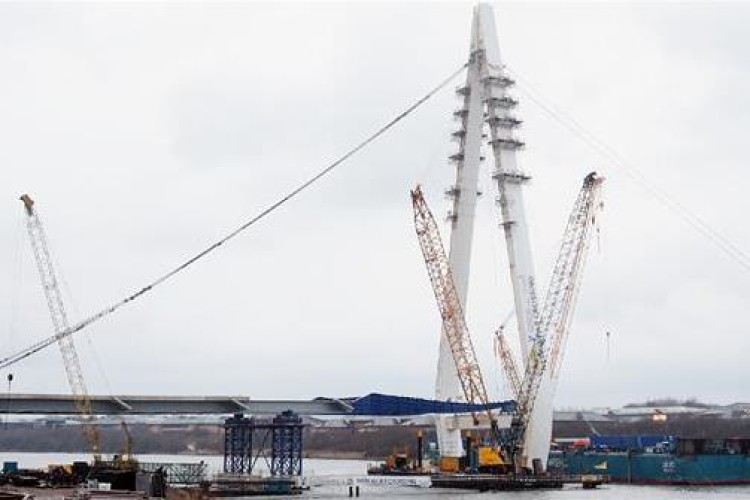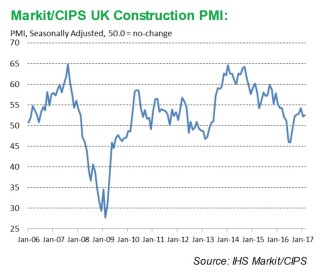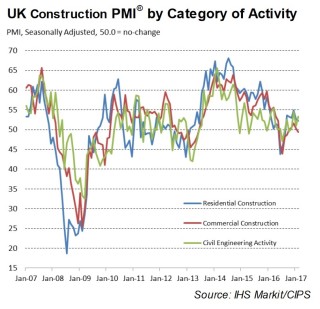The latest monthly survey of construction purchasing managers indicates continuing expansion across the industry, thanks to rising civil engineering activity.
February 2017 saw house-building activity increase at its slowest pace for six months, while commercial building declined for the first time since October 2016.
The latest survey also revealed a further expansion of employment numbers, despite the new business growth rate softening. Meanwhile, intense cost inflation persisted in February, which was overwhelmingly linked to higher prices for imported materials.
At 52.5 in February, up slightly from 52.2 in January, the seasonally adjusted Markit/CIPS UK Construction Purchasing Managers’ Index (PMI) registered above the neutral 50.0 threshold for the sixth consecutive month. However, the rate of output growth remained weaker than its post-referendum peak (54.2 in December 2016) and subdued in comparison to the trends seen over the past three-and-a-half years.
Survey respondents noted that the resilient economic backdrop and a stabilisation in client confidence since the EU referendum continued to help drive construction growth in February. However, there were also reports that demand growth had softened so far in 2017. Reflecting this, incoming new work increased only marginally and at the slowest pace since last October. Some construction companies noted that sharply rising input costs had an adverse impact on decision-making and contributed to delays in contract completions.
February data also indicated that construction companies remain upbeat about their growth prospects for the next 12 months, with 48% forecasting a rise in business activity and only 13% expecting a decline. The degree of positive sentiment was stronger than seen on average in the second half of 2016, but weaker than January’s 13-month peak.
Strong demand for house-building was cited as a key factor likely to boost construction output.

Subcontractor demand also picked up, which contributed the sharpest drop in subcontractor availability since January 2016.
Input buying increased again in February, although the rate of expansion was only marginal. Greater pressure on supplier capacity led to the sharpest deterioration in vendor performance since June 2015. Construction companies also reported the second-fastest rise in input costs since August 2008.
Tim Moore, senior economist at IHS Markit and author of the Markit/CIPS Construction PMI, said: “February’s survey data highlights that the UK construction sector has rebounded from its post-referendum soft patch but remains on a relatively slow growth trajectory. Weaker momentum in the house building sector was a key factor weighing on construction growth, alongside a renewed fall in work commercial projects.
“There was little sign that the UK storms had a material impact on construction growth in February, although some firms noted that longer delivery times for roof tiles had added to supply chain issues. Instead, survey respondents mainly cited an underlying slowdown in sales growth, with the latest rise in new work the weakest for four months. In some cases, construction companies reported that sharply rising input prices had a disruptive impact on contract negotiations.
“February data revealed that input cost inflation remained at levels last seen in the summer of 2008. Suppliers’ efforts to pass on rising energy costs and global commodity prices have been amplified by the weak sterling exchange rate.”
Got a story? Email news@theconstructionindex.co.uk




.gif)
